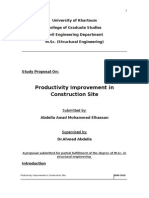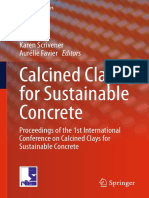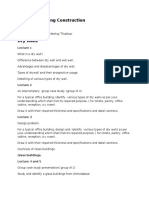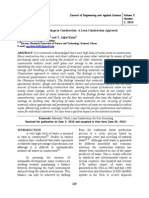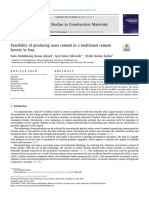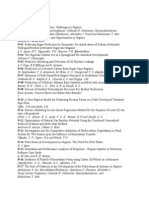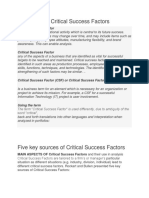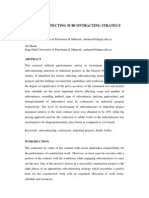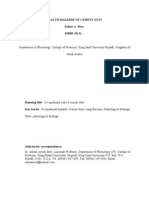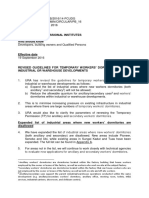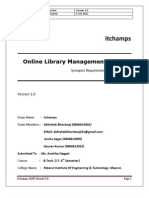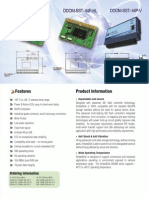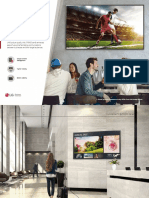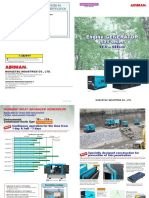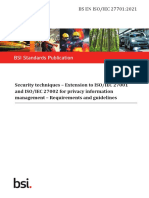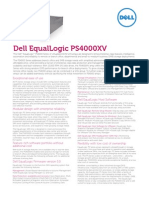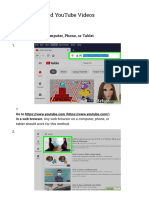Slaughter - 1998 MODELS OF CONSTRUCTION INNOVATION PDF
Slaughter - 1998 MODELS OF CONSTRUCTION INNOVATION PDF
Uploaded by
Débora BretasCopyright:
Available Formats
Slaughter - 1998 MODELS OF CONSTRUCTION INNOVATION PDF
Slaughter - 1998 MODELS OF CONSTRUCTION INNOVATION PDF
Uploaded by
Débora BretasOriginal Title
Copyright
Available Formats
Share this document
Did you find this document useful?
Is this content inappropriate?
Copyright:
Available Formats
Slaughter - 1998 MODELS OF CONSTRUCTION INNOVATION PDF
Slaughter - 1998 MODELS OF CONSTRUCTION INNOVATION PDF
Uploaded by
Débora BretasCopyright:
Available Formats
MODELS OF CONSTRUCTION INNOVATION
By E. Sarah Slaughter,l Associate Member, ASCE
ABSTRACT: Construction innovation offers the potential for significant company, industry, and societal benefits.
The objective of this paper is to present five models of construction innovation,. which can provide a basis u~n
which companies can select and implement the innovations. Based upon current management and econOffilC
theories of innovations, the models reflect the unique conditions of constructed facilities, including the scale,
Downloaded from ascelibrary.org by UFRGS - Universidade Federal do Rio Grande do Sul on 07/04/15. Copyright ASCE. For personal use only; all rights reserved.
complexity, and longevity of the facilities, as well as their organizational and social contexts. The innovations
are differentiated by their degree of change from current practice, and their link~ to. other ~ompone?ts ~d
systems. The five models are incremental, modular, ar~hi~ectural, sys~m, an~ .r~dical. innovations. U.Si~g this
categorization of innovations, companies can plan th~ir implementation actiVities Wi~ respe~t. to tiffilng of
commitment, coordination among the project team, SpeCial resources, and level of superviSOry actiVity. Examples
of construction innovations in each category are discussed.
INTRODUCTION vices, and reductions in the cost of production. In construction,
improved components and technologies are constantly appear-
Although the generally accepted perception of the construc- ing. For example, the current security and communications
tion industry views innovation as a rare occurrence, in actu- subsystems in buildings are significant improvements over
ality it occurs consistently throughout the sectors of the in- those existing even ten years ago. Mechanization of many con-
dustry (Dibner and Lerner 1992; Johnson and Tatum 1993; struction tasks has reduced the cost of construction through
Slaughter 1993a). In addition, companies within the industry decreasing the labor hours required. New markets can also
are interested in innovative technologies and designs, whether emerge based upon innovations, as with the construction of
relating to materials, components, systems, methods, equip- high technology industrial facilities and Class 1 clean rooms
ment, management, or other related areas. The objective of for semiconductor manufacturing.
providing this framework of models of construction innovation Construction-related innovations can also have significant
is to guide selection and implementation activities by construc- social benefits (Seaden 1996). When the cost of constructed
tion companies. Using the concepts presented here, it is hoped facilities is reduced, the facilities themselves become more af-
that a construction company could more effectively plan and fordable, and, therefore, more accessible to a greater propor-
carry out a strategy to identify, acquire, develop, and imple- tion of the population. Improvements in the efficiency of res-
ment construction innovations. idential construction to improve the quality of life for citizens
To establish a common basis for discussion, innovation is is a focus of many national construction programs. In the same
clearly distinguished from invention. Invention is a detailed way, reducing the environmental impacts of construction-re-
design or model of a process or product that can clearly be lated activities through innovations provides social benefits re-
distinguished as novel compared to existing arts. Innovation, gionally, as well as globally.
on the other hand, is the actual use of a nontrivial change and In particular, for construction, innovations often increase the
improvement in a process, product, or system that is novel to technical feasibility of construction undertakings. Projects or
the institution developing the change (Freeman 1989). In con- facilities that may appear to be beyond the current technolog-
trast to an invention, an innovation does not require a detailed ical frontier can become possible. For instance, the design for
design or physical manifestation, and it does not have to. be the Normandy Bridge extended by 60% the perceived maxi-
novel with respect to the existing arts, but only to the creatmg mum feasible length for a cable-stayed bridge (Shimizu 1997).
institution. While an innovation could also be an invention, an Other research has demonstrated the preponderance of con-
invention is not an innovation unless it has actually been used. struction-related innovations that are new solutions to identi-
fied problems or technical constraints (Becker 1991; Dibner
BENEFITS FROM CONSTRUCTION INNOVATIONS and Lemer 1992; Bruce et al. 1995).
Innovations may also provide significant benefits that cannot
Among the many macroeconomic benefits attributed to in- be adequately measured in direct monetary savings and gain,
novation are, most commonly, an increase in economic growth but can, nonetheless, add to a company's competitive position.
(Schumpeter 1934) and an increase in productivity (Schmook- For both the innovators and the early users of the innovations,
ler 1952). While there is significant disagreement about the certain intangible benefits can be obtained from innovations,
rate at which construction productivity and efficiency have such as improved reputation, ease of work, and attraction of
been increasing over the last few decades, there is undeniably promising new hires. These intangible benefits can often be
room for improvement. Indeed, the White House Committee more important for the early use of innovations than the ex-
has released ambitious goals for the improvement in the pro- pected dollar savings, as examined in the adoption of new
vision of construction activities ("National" 1994), and other information technologies for construction (Ramcharan 1997).
countries have identified similar goals (Latham 1994).
Innovation can also be associated with market growth, MODIFICATION OF INNOVATION MODELS FOR
through the provision of new or improved products and ser- CONSTRUCTION
'Asst. Prof., Dept. of Civ. and Envir. Engrg., MIT, 77 Massachusetts Innovation as a field of study has existed for several dec-
Ave., Rm. 1-174, Cambridge. MA 02139. E-mail: slaughte@mit.edu. ades, focusing primarily on the manufacturing sector of na-
Note. Discussion open until November I, 1998. To extend the closing tional economies (Tushman and Moore 1988). However, cer-
date one month. a written request must be filed with the ASCE Manager tain key differences distinguish construction from manu-
of Journals. The manuscript for this paper was submitted for review and facturing activities, and· the nature of these differences can
possible publication on July 15. 1997. This paper is part of the Journal
of Construction Engineering and Management. Vol. 124. No.3. Mayl provide insights into how the existing innovation models and
June. 1998. ©ASCE. ISSN 0733-9364/98/0003-0226-0231/$8.00 + $.50 theories must be modified to reflect the characteristics of the
per page. Paper No. 16200. construction-related activities. Specifically, constructed facili-
2261 JOURNAL OF CONSTRUCTION ENGINEERING AND MANAGEMENT I MAYIJUNE 1998
J. Constr. Eng. Manage. 1998.124:226-231.
ties are large, very complex, and long lasting, and they are guidelines, monitored through frequent inspections, and en-
created and built by a temporary alliance of disparate organi- forced through strong fines and penalties. The operation is also
zations within an explicit social and political context. overseen through frequent inspections and documented per-
The physical scale of the components and the completed formance tests. Decommissioning requires activities and over-
facility establish certain operational constraints that affect the sight similar to those for design and construction, with the
development and use of innovations. For instance, activities to added constraints of long-term liability for environmental con-
assemble the components are performed primarily at the final ditions. Manufactured products, in contrast, are most often
location of the facility. Off-site fabrication and assembly ac- evaluated with respect to their performance and not prescribed
tivities in shops and controlled environments are limited to the in their design 1lI1d fabrication, even for products, which, like
space available and to the transportation requirements of the automobiles, may have significant health and safety impacts.
Downloaded from ascelibrary.org by UFRGS - Universidade Federal do Rio Grande do Sul on 07/04/15. Copyright ASCE. For personal use only; all rights reserved.
unit. Therefore, innovations that require controlled environ- In addition, liability is more often borne by the manufacturing
ments or conditions during implementation may be limited in company or the industry sector as a whole, rather than the
their application. Second, when an innovation is tested, the individual designers, workers, or supervisors, as is common in
most reliable results are obtained from full-scale prototypes, construction.
since the scale effects for built facilities can be significant. For the effective development of models of construction in-
Full-scale tests can be expensive and time-consuming, and novation, the combination of the attributes of constructed fa-
only a few facilities in anyone country have the capacity for cilities (scale, complexity, and durability of the facilities, to-
these tests. gether with the organizational and sociopolitical contexts)
The complexity of facilities introduces another operational influences the nature of the innovation and how it is devel-
constraint on the development and use of innovations. Most oped, acquired, and implemented. These factors create an en-
facilities consist of a number of different systems which in- vironment that differs from the context often assumed for man-
teract with each other as well as with the specific environment, ufacturing innovation models. For example, many of those
and these interactions are not comprehensively characterized. models assume that the innovations are generated by an inter-
Introducing an innovation may create perturbations throughout nal research and development (R&D) organization that
the other systems that may often be difficult to trace defini- chooses from among a set of promising research pathways
tively. Unlike a manufacturing product where the set of inter- (Nelson and Winter 1982), and that the innovations can be
actions can often be constrained, constructed facilities interact exploited through large scale mass production (Abernathy and
with an open set of components and systems, and with the Utterback 1978).
environment itself.
A third factor differentiating constructed facilities from MODELS OF CONSTRUCTION INNOVATION
manufactured products is their longevity of use. Most public
facilities have a specified design life of at least 50 years, and Although many theoretical models of innovation exist, the
often longer. Certain critical infrastructure systems, such as objective here is to provide a set of models that responds to
aqueducts, have functioned for hundreds of years. Therefore, the nature of the construction industry and the activities of
construction innovations must be assessed not only within the specific construction companies. The organizing principles for
original installation context, but also over a very long time these models are (I) the magnitude of change from current
period. For this reason, the potential for failure and the failure state-of-the-art associated with the innovation; and (2) the ex-
mode for an innovation must be explicitly considered, as well pected linkages of the innovation to other components and
as the strategy for extracting, repairing, or modifying the in- systems. These two attributes can combine to provide insight
novation within the facility through several decades. into effective implementation strategies and potential sources
of these types of innovations.
The organizational context of construction innovations dif-
fers significantly from a great portion of manufacturing inno-
vations. Construction innovations exist within a temporary al- Incremental and Radical Innovations
liance among independent organizations concentrated on a The two ends of a spectrum of innovation models can be
single project. After the project is completed, the alliance is defined as incremental innovation and radical innovation (Mar-
dissolved. Unlike traditional manufacturing organizations, quis 1988). Incremental innovation is a small change, based
which have a set of permanent in-house resources for design upon current knowledge and experience. In contrast, a radical
and implementation, construction projects most often split the innovation is a breakthrough in science or technology that of-
design, fabrication, and implementation activities among many ten changes the character and nature of an industry. While
different parties. In addition, manufacturing companies often incremental innovations occur constantly, radical innovations
have a fairly stable set of suppliers from whom they obtain are rare and unpredictable in their appearance and in their
components and other inputs. In construction, the set of sup- impacts. For incremental innovations, the impacts are predict-
pliers are selected for each project and are often not repeated able within a fairly narrow range, and the interactions with
on future projects. Innovations that require even small modi- other components and systems is expected to be negligible. A
fications in other components, systems, or activities require a radical innovation creates a new way of understanding a phe-
degree of interorganizational negotiation that is beyond the nomenon and formulating approaches through which to solve
normal manufacturing requirements. problems (Nelson and Winter 1977; Dosi 1982). All previous
A final factor for the modification of existing innovation linkages and interactions may be irrelevant for a radical in-
models for application to construction is the social and polit- novation, not only with respect to the systems, but also the
ical context of constructed facilities. Because constructed fa- ties among organizations.
cilities directly influence the safety, health, and well-being of Examples of incremental and radical innovations within
the population, all portions of a facility's life cycle (design, construction can illustrate the models. A recent incremental
construction, operation, and decommissioning) are circum- construction innovation is a full-body safety harness for fall
scribed by codes and regulations. Design of a facility has to prevention made from material similar to a mountain climber's
be conducted within the guidelines, and often to detailed spec- gear, an incremental improvement over the waist-level safety
ifications, established through significant experience and cod- belts. As new construction regulations increase the require-
ified in rule making. The construction itself is conducted in ments for workers to "tie off" When they are working off the
many parts of the world within strict safety and environmental ground, the construction equipment manufacturers have re-
JOURNAL OF CONSTRUCTION ENGINEERING AND MANAGEMENT / MAY/JUNE 1998/227
J. Constr. Eng. Manage. 1998.124:226-231.
sponded to make their harnesses more flexible to accommo- tural innovation is most often a company that does not have
date the workers' movements and to provide support over a a vested interest in maintaining the existing linkages. How-
greater length of the body in case of a fall (Korman 1997). A ever, in order for an architectural innovation to succeed, the
radical innovation in construction from over a hundred years originator and users of architectural innovations must under-
ago was the introduction of structural steel. Its appearance was stand the required changes in the linkages. In manufacturing,
unexpected and changed the type of buildings and structures architectural innovations most often appear from new entrants
that could be designed and built. A whole new industry of to an industry, in the form of new manufacturing companies.
steel manufacturing and fabrication emerged, as well as new In construction, preliminary analysis indicates that architec-
components and systems linked to the new structural forms tural innovations may well originate in the field (e.g., general
and systems (Elliott 1994). and specialty contractors) rather than manufacturers and sup-
Downloaded from ascelibrary.org by UFRGS - Universidade Federal do Rio Grande do Sul on 07/04/15. Copyright ASCE. For personal use only; all rights reserved.
The sources of incremental and radical innovations differ as pliers (Slaughter 1993b).
well. Incremental innovations most often appear within the
organization that has the knowledge base upon which to de- System Innovation
velop improvements (Marquis 1988). These organizations in
construction can include all parties in the value chain, from System innovations are identified through their integration
suppliers and manufacturers for their own products, to con- of multiple independent innovations that must work together
tractors and workers in the materials, methods, and manage- to perform new functions or improve the facility performance
ment they use, to the owners and occupants related to the as a whole. For this type of innovation, the linkages are ex-
performance of the facility. Radical innovations, on the other plicitly among the innovations, as well as often entailing
hand, often appear from outside an existing industry and are changes in the links to other components and systems (Cain-
often based upon scientific or engineering research. They may arca et al. 1989). The innovations often come from a variety
be introduced into an industry through any number of avenues, of different sources, and must be explicitly connected and
but most often involve the entrance of new companies and modified among the components of the systems. As noted pre-
organizations into an industry. viously, constructed facilities are complex systems, which are
characterized by the integration of a changing set of compo-
Modular and Architectural Innovations nents and systems that must interact to perform the overall
function and meet conditions of the environmental context
The distinction between modular and architectural innova- over time. System innovations appear with a relatively high
tions is made on the region of the change and, specifically, the degree of frequency in the construction industry (Hutcheson
degree of interaction with other components or systems. Mod- et al. 1996; Kangari and Miyatake 1997), since systems are
ular innovation entails a significant change in concept within reconfigured for each project, which provides an opportunity
a component, but leaves the links to other components and to incorporate a set of innovations that can complement each
systems unchanged. Architectural innovation, on the other other to achieve new functions or levels of performance.
hand, involves a small change within a component, but a major An example of a recent system innovation is the zone mod-
change in the links to other components and systems (Hen- ule construction method for large, coal-fired power plants
derson and Clark 1990). This distinction has important impli- ("Zone" 1996). For this innovation, the plant is prefabricated
cations for the implementation of these innovations. Modular in four large-side zone modules and one top module. Each
innovations may be developed within an organization and im- module includes the structural elements, piping, equipment,
plemented with a minimum of negotiation with parties in- electrical and control wiring, and other installed components.
volved in the development or selection of other components, The top module acts as the lifting platform for the lower mod-
whereas architectural innovations require change and modifi- ules. This system innovation replaces on-site placement of
cation in the set of interacting components and systems (Afuah each component with prefabrication of the whole plant,
and Bahram 1995). thereby minimizing on-site activities. It incorporates several
An example of a modular innovation is a new machine that specific independent innovations (e.g., split boilers and hy-
automatically ties the wire for reinforcing bars in cast-in-place draulic lifting devices) and requires the integration of all the
concrete ("Talon 2 " 1996). To mechanize this activity is a sig- modules and their components, as well as the coordination of
nificant change in concept, and involves many novel and pat- all activities related to design, fabrication, erection, and con-
ented devices, but it does not change any of the other nection among each of the zone modules to ensure the per-
components, methods, or materials related to cast-in-place formance of the facility as a whole.
concrete. A recent innovation that can demonstrate the concept Similar to the innovation sources for architectural innova-
of an architectural innovation is self-compacting concrete tions, the sources for system innovations are most often enti-
(Okamura et al. 1995). This concrete uses standard available ties that do not have a vested interest in the current configu-
materials in the cement, admixtures, and aggregate, but con- ration of components, subsystems, and systems, but rather
trols their size and homogeneity to the extent that the vibration obtain significant benefits from the improved performance or
stage of placing the concrete is eliminated. In addition, the new functions provided by the integration and complementar-
cured concrete appears to have improved performance in du- ity of multiple innovations. The innovator also is able to ex-
rability, impermeability, and strength. Therefore, while the ercise the technical competence and project responsibility and
new concrete has only relatively minor changes within the control to achieve coordination and cooperation across the sys-
basic technical field of concrete composition, it has major im- tem(s). The requirements to effectively develop and use system
plications in the linkages to construction activities through the innovations often runs counter to common project delivery
elimination of the consolidation phase and increased rates of systems where control and responsibility are split among dif-
placement. ferent organizations by specific tasks or technical subsystems.
In construction, it appears that modular and architectural
innovations can come from a variety of sources. Modular in- Summary of Construction Innovation Models
novations may be developed within organizations that have
control over and responsibility for the module, or they may be The five types of innovation presented through the models
introduced through a new entrant into the industry. Because can be ordered by their degree of required change from the
architectural innovations require changes in the linkages to current state-of-the-art or practice (Fig. 1). Incremental inno-
other components and systems, the developer of an architec- vation is a small change, with impacts confined to the im-
228/ JOURNAL OF CONSTRUCTION ENGINEERING AND MANAGEMENT / MAY/JUNE 1998
J. Constr. Eng. Manage. 1998.124:226-231.
Scale of Innovation Models attributes of the magnitude of the change and the linkages to
MojoT
a-g. other components and systems. companies can predict and
plan for different types of activities depending upon the type
I I I of innovation involved. Although several models exist for im-
Incremental Modular Architectural System Radical plementing construction innovations (Tatum 1987; Laborde
•
• t
....e-'
+ ~I·r
and Sanvido 1994), this approach will focus on the five models
of innovation and specific activities and resources needed to
use the innovations on specific projects.
The first consideration is the timing of the commitment to
use the innovation. The commitment is the degree to which
Downloaded from ascelibrary.org by UFRGS - Universidade Federal do Rio Grande do Sul on 07/04/15. Copyright ASCE. For personal use only; all rights reserved.
FIG. 1. Innovation Models for Construction resources are assigned to the implementation of the innovation.
and when an organization may publicly acknowledge its use
provement of the specific element or component. A modular of the innovation. The timing is with respect to the progress
innovation is a more significant change in the basic concept. of the project, through the stages of feasibility analysis, con-
but it also has limited impacts on other components or sys- ceptual design. detailed design, bid award. construction. and
tems. Architectural innovations. on the other hand. may entail turnover. If the timing of the commitment to the innovation
only a small change within a concept or component. but are must correlate to other scheduled events (such as acceptance
strongly linked and interactive with other components and sys- of bid). then the potential user of the innovation must collect
tems. and so require changes in the linkages or the linked adequate information. evaluate the innovation. and make a de-
units. With the system innovation. the linkages are among mul- cision appropriate to the specific project in time to incorporate
tiple innovations that must be integrated together and may re- it into the project plans. On the other hand, if the innovation
quire significant changes in other components and systems. as commitment can be made independently of the project sched-
well as the linkages to those elements. A radical innovation is ule. the potential user can make that decision based upon other
a new approach and causes major changes in the nature of the factors, such as the innovation being a solution to an emerging
industry itself. appearing as a rare and unpredictable event. problem.
almost as a "shooting star." The degree to which use of an innovation requires implicit
For construction companies searching for innovation. the and explicit coordination among the members of the project
innovations may be quite close to home. The general catego- team. including the client. designers. contractors. subcontrac-
ries of sources of innovation are research and development tors. and other contractual parties. is the second consideration.
(R&D) organizations (e.g.• universities and research and test- Implicit coordination can include informal negotiation and col-
ing laboratories). manufacturers and suppliers. designers. con- laboration to solve problems, exchange information, and co-
tractors and workers, and the owner and occupants. both ordinate activities, while the explicit coordination may include
within and outside the construction-related industry. special provisions in the contract for design or construction
Incremental innovations appear most often within the or- changes, signatures for acceptance of risk or uncertainty. or a
ganizations that have the knowledge. experience, and control waiver of penalties for late project completion. If use of an
to affect the improvements. which can be any of the organi-
innovation does not require implicit or explicit coordination,
zational types listed as sources. In construction, previous stud-
it can be implemented with ease. while significant explicit and
ies have indicated that incremental innovations are even more
common in this industry than in other industries and often implicit coordination among the team members may signifi-
occur within the construction companies themselves (Myers cantly complicate the implementation process.
and Marquis 1969). Modular innovations, likewise, originate The use of an innovation may require special resources
within a technically competent organization, but because they (e.g.• special equipment or trained personnel). and these re-
involve an advancement in the general concept on which an sources may only exist within specialty companies. Therefore,
element is based, they may more often appear in organizations the third consideration for the incorporation of an innovation
with higher specialized technical capabilities, such as R&D into a specific project is the type and source of special re-
organizations. and manufacturers and suppliers that support sources. If the resources are difficult to obtain. the innovation
specialized development activities. may not be appropriate for many projects, or the benefits that
Architectural innovations may originate at any of the are expected to accrue from the innovation may be captured
sources, but the modifications of the linkages requires an or- by the supplier of the special resources through high fees. A
ganization with knowledge of and control over the affected company may decide to develop those special resources in-
components and systems. such as the contractors and owners. house. such as through a training program, but the associated
System innovations require technical competence equivalent costs from internalizing the special resources that are needed
to that needed for modular innovations. as well as the knowl- may be greater than the benefits that are probable for a single
edge and control equivalent to that needed for architectural project. and future applications may be uncertain. When an
innovations. combined with organizational authority to ensure innovation does not require special resources, or when those
collaboration and integration. With these requirements. the in- resources can be found or easily developed within the com-
dividual innovations may come from any of the sources. but pany. the implementation of the innovation can proceed more
the integrating source is more likely to be an organization with smoothly and generally at a lower cost than innovations that
design and implementation capabilities. with strong relation- need external special resources.
ships with or ties to the owner. Radical innovations. in con- The fourth consideration is the nature of the supervision
trast. will most likely be developed within organizations with activities. including the organizational level at which the su-
strong scientific and engineering competencies. such R&D or- pervision is required, the type of supervisory activity. and the
ganizations, or in industries with high R&D concentrations and specific competencies of the supervisors. The organizational
expenditures, such as materials and communications. level of the supervision may differ by innovation type. since
some innovations may require supervision only at the level of
INCORPORATION OF INNOVATIONS WITHIN the performance of the task. whereas others may require su-
PROJECTS
pervision by the upper levels of the management structure. In
The five innovation models can provide the basis for a strat- the same way. the types of supervision may range from simple
egy to incorporate innovations into specific projects. Using the notification to active involvement and decision-making to
JOURNAL OF CONSTRUCTION ENGINEERING AND MANAGEMENT / MAY/JUNE 1998/228
J. Constr. Eng. Manage. 1998.124:226-231.
TABLE 1. Specific Activities for Implementation by Type of Innovation
Coordination Supervision
Types of Timing of within project Special organizational Supervision Supervision
Innovation commitment team resources level type competency
(1 ) (2) (3) (4) (5) (6) (7)
Incremental At any time None None At locus of im- Notification Specific product or pro-
provement cess
Modular At design/selection None For concept change At design level Notification, review Technical competency
Architectural At design-to-implemen- Among affected For complementary At affected system Notification, agree- System competency
tation stages parties changes level ment, review
Downloaded from ascelibrary.org by UFRGS - Universidade Federal do Rio Grande do Sul on 07/04/15. Copyright ASCE. For personal use only; all rights reserved.
System At conceptual design With all project For integration of set At top engineering Project scope, Technical and system
stage team members of innovations management level agreement, review competency
Radical At technical feasibility With top manage- For breakthrough At top management Project objectives Specialized technical
stage ment from all in- level and scope competency
volved organiza-
tions
strategy formulation of the company as a whole. The specific fewer special resources, but a greater degree of commitment,
competencies can include supervisory knowledge and experi- coordination, and supervision. Architectural innovations often
ence, and may be task-specific, or may need to include spe- involve only a small change within a core concept, but major
cialized scientific or engineering fields. changes in the linkages to other components and systems. This
A critical point to make at this juncture is that an innovation apparent small degree of change may lead to a wider range of
is most usefully categorized for this discussion with respect to timing for commitment, from design to implementation, but
the implementing construction organization. An innovation often requires extensive explicit, as well as implicit, coordi-
that is categorized as "radical" to one field may be viewed as nation among the members of the project team. If the required
"modular" to a different area (Afuah and Bahram 1995). For modifications for the architectural innovation requires new de-
example, a new mapping and surveying device, the Cyrax, liverables in either the performance of work or the components
uses a laser-radar transmission to measure the surfaces of a involved, the explicit coordination will include contract
facility, and transforms those measurements into a three-di- changes. At the least, the architectural innovations will require
mensional CAD image during the mapping activity ("Lasers" implicit coordination, with special resources associated with
1997). It may well be a radical innovation to the industry that the complementary changes. The supervisory activities will be
currently produces as-built facility measurements and draw- quite active, primarily at the implementation site for the full
ings, since it will completely transform its activities, and pos- system being affected, and will entail notification, agreement,
sibly its composition of companies. On the other hand, for the and constant review and revision activities to ensure the per-
construction company that will use the measurements and formance of the completed system. The supervisor's compe-
drawings for maintenance, repair, retrofit, and decommission- tence will have to be at the system level, including not only
ing projects, it is a modular innovation, since it is a change in implementation, but operation.
concept, without requiring any changes in the use of the CAD System innovations require earlier commitment from more
images or other related construction functions. of the organization than is needed for architectural innova-
The specific activities required for the five types of inno- tions. Commitment to a system innovation is made during the
vations can be presented as an increasing level of complexity conceptual design phase, since it often involves new functions
corresponding to the degree of change associated with the in- or increased levels of performance of the facility as a whole.
novation (Table 1). Incremental innovations can be committed The identification and implementation of the set of innovations
to at any time in the project, since they do not involve major and their integration into the system require the explicit and
changes, but only small improvements. They also do not re- implicit coordination among the team from the earliest stages,
quire explicit or implicit coordination within the project team, with the special resources related to each of the innovations,
or special resources. The level of supervision is at the locus and their integration. The risk associated with the use of a
of the improvement (e.g., task level) and concerned primarily system innovation may require active supervision by top en-
with notification, with supervisory competencies needed in the gineering managers, who are concerned with incorporating it
product or process being improved. into the project scope, obtaining agreements, and constantly
Because modular innovations involve a change in a core reviewing its implementation and performance. These super-
concept, the associated activities for use require an earlier visors need technical and system competence to assess the
commitment, usually during the design or bid stages. Since complementary changes needed to effectively implement the
many construction specifications define in detail acceptable system innovation.
components and processes, changes must be explicitly identi- Implementation of a radical innovation entails not only fi-
fied and agreed upon within the design scope. However, be- nancial and project risk, but also the potential for technical
cause modular innovations do not require changes in the link- failure. These innovations are often assessed well before a spe-
ages to other components and systems, it requires little explicit cific project is initiated and are explicitly considered during
or implicit coordination within the project team. The special the technical feasibility analysis. Coordination for explicit and
resources required are access to the innovation itself and to implicit cooperation will involve top management from all in-
the related concept change (e.g., training to install and main- volved organizations, and requires special resources related to
tain a component embodying a modular innovation). The su- the scientific or technological breakthrough. The supervision
pervision required is, therefore, primarily at the design or bid will also involve the top management levels, because of the
levels and requires notification and review to ensure that the risk involved, and will relate specifically to the project objec-
modular innovation will meet the project's requirements. The tives and scope. However, the top management will probably
supervisor will have to possess some degree of technical com- need to supplement their competencies with specialists in the
petency in the core concept area to adequately evaluate the specific scientific or technology area related to the break-
innovation and oversee its implementation. through, to monitor the implementation process and adjust the
Architectural innovations, on the other hand, may require activities or innovation accordingly.
230/ JOURNAL OF CONSTRUCTION ENGINEERING AND MANAGEMENT / MAY/JUNE 1998
J. Constr. Eng. Manage. 1998.124:226-231.
The categorization of an innovation into one of the five tionary pattern of innovation diffusion: the case of flexible automa-
models (incremental, modular. architectural, system, and rad- tion." Res. Policy, 18, 59-86.
Dibner. D. R., and Lerner, A. C. (1992). The role of public agencies in
ical) can provide a basis for predicting the degree of change fostering new technology and innovation in building. National Acad-
from standard practice associated with the innovation, and for emy of Sciences Press, Washington. D.C.
planning the type of activities and resources necessary to ef- Dosi. G. (1982). "Technological paradigms and technological trajecto-
fectively implement the innovation. The specific considera- ries." Res. Policy, II, 147-162.
tions are the timing of commitment. the degree of coordination Elliott, C. D. (1994). Technics and architecture. MIT Press, Cambridge,
Mass.
within the project team, need for special resources, and the Freeman, C. (1989). The economics of industrial innovation. MIT Press,
type and level of active supervision. In general, as the degree Cambridge, Mass.
of change associated with an innovation increases, the activi- Henderson, R. M .• and Clark, K. B. (1990). "Architectural innovation:
Downloaded from ascelibrary.org by UFRGS - Universidade Federal do Rio Grande do Sul on 07/04/15. Copyright ASCE. For personal use only; all rights reserved.
ties and resources must increase as well. the reconfiguration of existing product technologies and the failure of
established firms." Administrative Sci. Quarterly, 35. 9-30.
Hutcheson, P., Pearson, A. W., and Ball, D. E (1996). "Sources of tech-
CONCLUSIONS nical innovation in the network of companies providing chemical pro-
cess plant and equipment." Res. Policy, 25. 25-41.
Construction innovation offers the potential for significant Johnson. K. D.• and Tatum, C. B. (1993). "Technology in marine con-
company, industry, and societal benefits. As the demand rises struction firms." J. Constr. Engrg. and Mgmt., ASCE. 119(1), 148-
for increasingly complex facilities, and the traditional sources 162.
of construction materials and labor shrinks, most construction- Kangari, R., and Miyatake. Y. (1997). "Developing and managing inno-
related companies are looking for design and technology in- vative construction technologies in Japan." J. Constr. Engrg. and
Mgmt.• ASCE, 123(1), 72-78.
novations to improve their products and services, and decrease Korman. R. (1997). "Signs of change." Engrg. News Rec., 28-32.
their costs. Owners and clients seek construction innovations Laborde, M., and Sanvido. V. (1994). "Introducing new process technol-
to increase the technical feasibility of their desired projects ogies into construction companies." J. Constr. Engrg. and Mgmt.•
and improve the performance of the completed facility, and ASCE, 120(3),488-509.
governments encourage the innovations as a means to improve "Lasers and satellites streamline projected plans." (1997). Engrg. News
the efficiency of the industry and the cost-effectiveness of the Rec.• 54-57.
Latham, M. (1994). "Constructing the team: joint review of procurement
facilities. and contractual arrangements in the United Kingdom construction in-
Five models of construction innovations are presented as a dustry." Dept. of Envir., London. England.
basis for construction companies to plan and carry out activ- Marquis. D. G. (1988). "Anatomy of successful innovations." Readings
ities to effectively use specific construction innovations. These in the management of innovation, M. L. Tushman and W. L. Moore,
models are based upon current theories in management and eds., Ballinger Publishing Co., Boston, Mass., 79-87.
economics but are modified to reflect the special conditions Myers. S., and Marquis, D. G. (1969). Successful industrial innovations:
a study offactors underlying innovation in selectedjirrns. Government
associated with constructed facilities, such as their scale, com- Printing Office, Washington, D.C.
plexity, durability, and organizational and sociopolitical con- National Institute of Standards and Technology. (1994). "Rationale and
texts. For the purposes of project incorporation, the five cat- preliminary plan for federal research for construction and building."
egories of innovation are differentiated with respect to their NISTlR 5536, Dept. of Commerce, Washington, D.C.
degree of change from current practices and their links to other Nelson, R. R.. and Winter, S. G. (1997). "In search of a useful theory of
innovation." Res. Policy, 6, 36- 76.
components and systems. Nelson, R. R.. and Winter, S. G. (1982). An evolutionary theory of eco-
Based on these models of innovation, companies can eval- nomic change. Harvard Univ. Press, Cambridge.
uate what they must do to implement the innovations. This Okamura. H., Ozawa, K., and Ouchi, M. (1995). "Self-compacting high
framework can provide companies with a means through performance concrete." J. Korea Concrete Inst., 7(5). 33-41.
which to reduce the perceived risks of using construction in- Ramcharan. R. (1997). "Strategic impact of innovations in information
novations, and to thereby somewhat lower the barriers to in- technology in construction," MSc thesis. MIT. Cambridge, Mass.
Schmookler, J. (1952). "The changing deficiency of the American econ-
novation throughout the industry. In addition, developers of omy, 1869-1938." Rev. of Economics and Statistics, 34, 214.
innovations can be made more aware of the level of commit- Schumpeter. J. (1934). The theory of economic development. Harvard
ment and change required to use their innovations and may be Univ. Press. Cambridge, Mass.
more willing to supplement the resources available to con- Seaden, G. (1996). "Economics of innovation in the construction indus-
struction companies to aid their implementation and spread. try." J. lnfrastruct. Sys., ASCE, 2(3), 103 - 107.
Shimizu, H. (1997). "Recent technology developments for long-span
bridges," MSc thesis. MIT. Cambridge, Mass.
APPENDIX. REFERENCES Slaughter, E. S. (1993a). "Builders as sources of construction innova-
tion." J. Constr: Engrg. and Mgmt., ASCE, 119(3).532-549.
Abernathy. W. J., and Utterback. J, M. (1978). "Patterns of industrial Slaughter. E. S. (1993b). "Innovation and learning during implementa-
innovation." Technol. Rev., 40-47. tion: a comparison of user and manufacturer innovations." Res. Policy,
Afuah, A. N., and Bahram, N. (1995). "The hypercube of innovation." 22,81-95.
Res. Policy, 24. 51-76. "Talon2 360 Rebar Tier," (1996). Talon Industries. Vail. Colo.
Becker. J. (1991). "Controlling results through innovation: the introduc- Tatum. C. B. (1987). "Process of innovation in construction firms." J.
tion of up/down construction in Boston." Constr. Business Rev.• 50- Constr. Engrg. and Mgmt., ASCE. 113(4).648-663.
54. Tushman. M. L.. and Moore, W. L. (1988). Readings in the management
Bruce, D. A., DiMillio. A. E. and Juran. I. (1995). "A primer on micro- of innovation. Ballinger Publishing Co., Boston. Mass.• 769.
piles." Civ. Engrg.• 65(12). 51-54. "Zone module construction method for large coal fired power plants."
Cainarca, G. C., Colombo. M. G.• and Mariotti. S. (1989). "An evolu- (1996). Mitsubishi Heavy Industries, Nagasaki. Japan.
JOURNAL OF CONSTRUCTION ENGINEERING AND MANAGEMENT 1 MAYIJUNE 1998/231
J. Constr. Eng. Manage. 1998.124:226-231.
You might also like
- BS en Iso 945-1-2019 - (2019-09-23 - 12-30-21 PM)Document42 pagesBS en Iso 945-1-2019 - (2019-09-23 - 12-30-21 PM)Hemant Chauhan100% (2)
- Statutory Instrument No. 106 of 1999 Cap 442Document28 pagesStatutory Instrument No. 106 of 1999 Cap 442Azariah Likezo TemboNo ratings yet
- Design Management in AECDocument11 pagesDesign Management in AECPushpendra Kumar100% (1)
- Status of The Construction IndustryDocument52 pagesStatus of The Construction IndustryZimenezo ayi100% (1)
- Productivity Improvement in Construction Site. Modification To ProposalDocument8 pagesProductivity Improvement in Construction Site. Modification To ProposalAbdallaNo ratings yet
- Calcined Clays For Sustainable Concrete Karen Scrivener, AurÇlie Favier, 2015Document552 pagesCalcined Clays For Sustainable Concrete Karen Scrivener, AurÇlie Favier, 2015Débora BretasNo ratings yet
- CatwalkDocument10 pagesCatwalkLesther Alexander CorreaNo ratings yet
- A Literature Synthesis of Innovation in Small Construction Firms Insights, Ambiguities and QuestionsDocument12 pagesA Literature Synthesis of Innovation in Small Construction Firms Insights, Ambiguities and QuestionsNurul AsyiqinNo ratings yet
- Effect of Organizational Culture On Delay in Construction PDFDocument12 pagesEffect of Organizational Culture On Delay in Construction PDFashikNo ratings yet
- Factors Influencing Construction Productivity in The Indonesian ContextDocument16 pagesFactors Influencing Construction Productivity in The Indonesian ContextDaniel PratamaNo ratings yet
- Factors Influencing Contractor Performance in Indonesia: A Study of Non Value-Adding ActivitiesDocument13 pagesFactors Influencing Contractor Performance in Indonesia: A Study of Non Value-Adding ActivitiesJaya PurnathaNo ratings yet
- Claim & Variation OrderDocument6 pagesClaim & Variation OrderKak NunuNo ratings yet
- ASTM E1557-02 UniformatIIDocument24 pagesASTM E1557-02 UniformatIIRaymond Carlson100% (2)
- Work Done ReportDocument443 pagesWork Done ReportNagarajNo ratings yet
- A Review Paper On The Effect of Sulphate Attack On Concrete DurabilityDocument7 pagesA Review Paper On The Effect of Sulphate Attack On Concrete DurabilityIJRASETPublicationsNo ratings yet
- Contract and Dispute Resolution CommitteeDocument128 pagesContract and Dispute Resolution CommitteeJasmine TsoNo ratings yet
- BSR 2019Document109 pagesBSR 2019aflal100% (3)
- Advance Building ConstructionDocument3 pagesAdvance Building ConstructionHitesh Sorathia0% (1)
- E - Waste BasicsDocument9 pagesE - Waste BasicsagsanghaniNo ratings yet
- Factors Influencing The Service Lifespan of Buildings An Improved Hedonic ModelDocument9 pagesFactors Influencing The Service Lifespan of Buildings An Improved Hedonic ModelResu LeirNo ratings yet
- Minimizing Materials Wastage in ConstructionDocument22 pagesMinimizing Materials Wastage in Constructionneeraj8162No ratings yet
- Martin CooneyDocument14 pagesMartin CooneyniallNo ratings yet
- BSR 2014 PDFDocument134 pagesBSR 2014 PDFRavindu RansaraNo ratings yet
- Replacement Cost New Less Depreciation ApproachDocument3 pagesReplacement Cost New Less Depreciation ApproachElizabeth GoNo ratings yet
- Value ManagementDocument6 pagesValue ManagementAsankaNo ratings yet
- Case Studies in Construction MaterialsDocument11 pagesCase Studies in Construction MaterialsgiannsNo ratings yet
- Environmental Life Cycle Assessment of A PDFDocument14 pagesEnvironmental Life Cycle Assessment of A PDFIndradi WijatmikoNo ratings yet
- Project Risk Management Practices in The Construction Industry in Ghana A Case Study of Two Construction Companies in Sekondi Takoradi MetropolisDocument10 pagesProject Risk Management Practices in The Construction Industry in Ghana A Case Study of Two Construction Companies in Sekondi Takoradi MetropolisInternational Journal of Innovative Science and Research TechnologyNo ratings yet
- Corruption in The Construction Industry of Nigeria PDFDocument4 pagesCorruption in The Construction Industry of Nigeria PDFGaniNo ratings yet
- Zlib - Pub Project Management Handbook For Engineers Construction Professionals and Business ManagersDocument531 pagesZlib - Pub Project Management Handbook For Engineers Construction Professionals and Business ManagersJoshua NicholasNo ratings yet
- Building Construction ReportDocument10 pagesBuilding Construction ReportRahul NawaniNo ratings yet
- Avoiding Cost Overruns in Construction PDocument11 pagesAvoiding Cost Overruns in Construction Pnasru hajiNo ratings yet
- NscheDocument230 pagesNscheappealmNo ratings yet
- Tendering Estimating Course Work Part 1Document15 pagesTendering Estimating Course Work Part 1frogy8812345No ratings yet
- Critical Factors Affecting Construction Labor Productivity in Egypt PDFDocument6 pagesCritical Factors Affecting Construction Labor Productivity in Egypt PDFFadlyAzhariMelchiorMarpaungNo ratings yet
- Types and Causes of Construction Claims IJERTV3IS120582Document4 pagesTypes and Causes of Construction Claims IJERTV3IS120582Yelisa Danny Denzel100% (1)
- Importance of Measurement of Labour Productivity in Construction by Pravin Minde & Prachi GhateDocument5 pagesImportance of Measurement of Labour Productivity in Construction by Pravin Minde & Prachi GhatePravin MindeNo ratings yet
- Construction Project ManagementDocument286 pagesConstruction Project Managementwilsonsulca100% (1)
- Automated Design Modular Buildings GCGANDocument21 pagesAutomated Design Modular Buildings GCGANsumit sahaNo ratings yet
- Carbon Dioxide Reduction Potential in The Global Cement Industry by 2050Document10 pagesCarbon Dioxide Reduction Potential in The Global Cement Industry by 2050Anonymous NxpnI6jCNo ratings yet
- Tall Buildings Survey 2018Document30 pagesTall Buildings Survey 2018AjayNo ratings yet
- 3D Concrete Printing in Construction (Ajay Kahandal)Document5 pages3D Concrete Printing in Construction (Ajay Kahandal)Umesh PatilNo ratings yet
- VM FinalizeDocument45 pagesVM FinalizeSinyuen YeohNo ratings yet
- Critical Sucess Factors With ExamplesDocument3 pagesCritical Sucess Factors With ExamplesAshish KumarNo ratings yet
- The Integration of Value and Risk Management Ininfrastructure ProjectsDocument14 pagesThe Integration of Value and Risk Management Ininfrastructure ProjectsShonette ThomasNo ratings yet
- Factors Affecting Subcontracting StrategyDocument12 pagesFactors Affecting Subcontracting StrategyAbdulrahman NogsaneNo ratings yet
- (F1E33F46 EA9C 4F75 A642 E0E0F31420BD) International Construction Costs 2018 Arcadis Updated 001Document11 pages(F1E33F46 EA9C 4F75 A642 E0E0F31420BD) International Construction Costs 2018 Arcadis Updated 001Ty BorjaNo ratings yet
- Azazo Dividers Sliding Walls Catalogue PDFDocument11 pagesAzazo Dividers Sliding Walls Catalogue PDFazazo dividers100% (1)
- List of Data Sets and ExamplesDocument6 pagesList of Data Sets and ExamplesVishal B PanchalNo ratings yet
- A. Preliminaries - General ConditionsDocument31 pagesA. Preliminaries - General Conditions2C Nur Izzati Binti RamleeNo ratings yet
- Value MethodologyDocument21 pagesValue Methodology1SABNo ratings yet
- Health Hazards of Cement DustDocument20 pagesHealth Hazards of Cement DustRamu BanothNo ratings yet
- Delay in ClaimDocument9 pagesDelay in Claimarvindalok1980No ratings yet
- CostX5.0 Advanced ManualDocument121 pagesCostX5.0 Advanced ManualHuynh Khuong DuyNo ratings yet
- ADU Construction SetDocument9 pagesADU Construction SetNasir UllahNo ratings yet
- dc16 14Document24 pagesdc16 14Subramanian SaravananNo ratings yet
- Improving Construction ProductivityDocument56 pagesImproving Construction ProductivitychienthangdoNo ratings yet
- Design and Analysis of Various Formwork SystemsDocument6 pagesDesign and Analysis of Various Formwork SystemsInternational Journal of Innovative Science and Research TechnologyNo ratings yet
- Optimization of Solar Power Using Diffused ReflectorsDocument15 pagesOptimization of Solar Power Using Diffused ReflectorsEngr Lanre Majek100% (1)
- Construction Innovation and Process ImprovementFrom EverandConstruction Innovation and Process ImprovementAkintola AkintoyeNo ratings yet
- Small Change, Big Gains: Reflections of an Energy EntrepreneurFrom EverandSmall Change, Big Gains: Reflections of an Energy EntrepreneurNo ratings yet
- (Haitao Et Al 2013) Lean Transformation in A Modular Building Company A Case For ImplementationDocument9 pages(Haitao Et Al 2013) Lean Transformation in A Modular Building Company A Case For ImplementationShanil ShahNo ratings yet
- 2016 Book TextileMaterialsForLightweight PDFDocument686 pages2016 Book TextileMaterialsForLightweight PDFDébora BretasNo ratings yet
- Laufer - Gestão Da ConstruçãoDocument11 pagesLaufer - Gestão Da ConstruçãoDébora BretasNo ratings yet
- Foaming Agents For Use in Producing Cellular Concrete Using Preformed FoamDocument6 pagesFoaming Agents For Use in Producing Cellular Concrete Using Preformed FoamDébora BretasNo ratings yet
- Online Library Management System, SRS, PHP MySql Abhishek Bhardwaj, Live Demonstration & Coding at Http://abhishekbhardwaj - TKDocument34 pagesOnline Library Management System, SRS, PHP MySql Abhishek Bhardwaj, Live Demonstration & Coding at Http://abhishekbhardwaj - TKabhishekbhardwa956988% (17)
- The Information Age Has Not Dramatically Improved in Everyday LifeDocument3 pagesThe Information Age Has Not Dramatically Improved in Everyday LifeShiela May BoaNo ratings yet
- Madhavi V6Document3 pagesMadhavi V6Dr. Sailaja BadeNo ratings yet
- Jmse 09 00036 v3Document15 pagesJmse 09 00036 v3Rizal FauziNo ratings yet
- Embeddisk DatasheetDocument2 pagesEmbeddisk DatasheetSandesh BhatNo ratings yet
- MFJ 2990Document11 pagesMFJ 2990Arthur Gevaerd NetoNo ratings yet
- UniTwainGuide PDFDocument25 pagesUniTwainGuide PDFradiocoronacNo ratings yet
- UT640S (ASIA) - Datasheet - TV Signage - Commercial TV - ID - LOW - 190705Document9 pagesUT640S (ASIA) - Datasheet - TV Signage - Commercial TV - ID - LOW - 190705OctavianusNo ratings yet
- The History of EntrepreneurshipDocument3 pagesThe History of EntrepreneurshipGloria JepkemeiNo ratings yet
- Purchase Order - 0002 PDFDocument1 pagePurchase Order - 0002 PDFCandidoskie BerdinNo ratings yet
- Economics For Managers - Session 06Document14 pagesEconomics For Managers - Session 06Abimanyu NNNo ratings yet
- L1 - 320introduction - Lec1Document26 pagesL1 - 320introduction - Lec1Mais SaedNo ratings yet
- SU5000MASSDocument2 pagesSU5000MASSHector Ernesto Cordero AmaroNo ratings yet
- Haemostasis: CatalogueDocument88 pagesHaemostasis: CatalogueArturo MoulderNo ratings yet
- KX-DT521/KX-DT543/KX-DT546 KX-DT590: Quick Reference GuideDocument24 pagesKX-DT521/KX-DT543/KX-DT546 KX-DT590: Quick Reference GuideZedana Dwi.PNo ratings yet
- Reciprocating Compressor Optimum Design and Manufacturing With Respect To Performance, Reliability and CostDocument6 pagesReciprocating Compressor Optimum Design and Manufacturing With Respect To Performance, Reliability and CostmustafaNo ratings yet
- En SDG PDFDocument8 pagesEn SDG PDFDuy KhaNo ratings yet
- BSI Standards PublicationDocument8 pagesBSI Standards PublicationdaviedNo ratings yet
- Amp Question BankDocument14 pagesAmp Question BankdibyenindusNo ratings yet
- Database FundamentalsDocument32 pagesDatabase Fundamentalshassan313.g4lNo ratings yet
- Equallogic ps4000xv SpecsheetDocument2 pagesEquallogic ps4000xv SpecsheetBrett GorleyNo ratings yet
- Module 1Document90 pagesModule 1ARUN KUMAR PNo ratings yet
- Module 3 (Part 1) : Determinants of Economic Development, Problems and Development StrategiesDocument5 pagesModule 3 (Part 1) : Determinants of Economic Development, Problems and Development StrategiesMark James GarzonNo ratings yet
- Mpaihs Tle TVL Monitoring Coaching PPT FuentesDocument39 pagesMpaihs Tle TVL Monitoring Coaching PPT FuentesErlyn AlcantaraNo ratings yet
- Southwire Shaft FurnaceDocument2 pagesSouthwire Shaft FurnaceГеоргий Романов100% (1)
- Cryptography: Implement A Restful Web ServiceDocument9 pagesCryptography: Implement A Restful Web Servicesaleem razaNo ratings yet
- Open VasDocument8 pagesOpen VasAlfa FoxtroxNo ratings yet
- 4 Ways To Download YouTube Videos - WikihowDocument30 pages4 Ways To Download YouTube Videos - WikihowClalisus ClaudiuNo ratings yet




